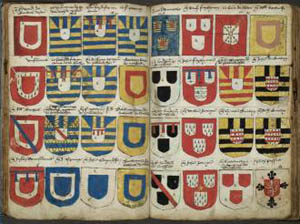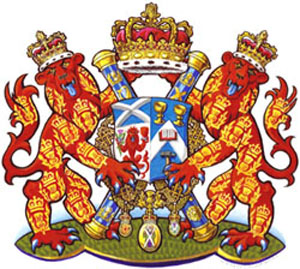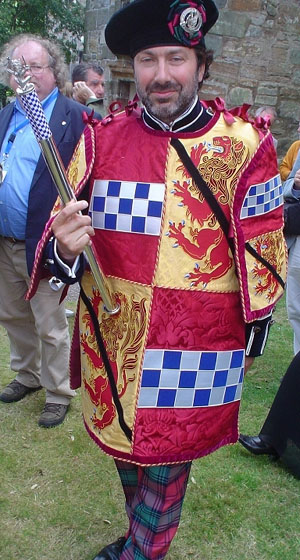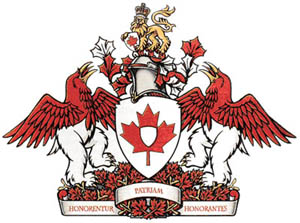International Heraldry - Officers of Arms |
| HOME | MY ARMS / GENEALOGY | NATIONAL HERALDRY | HATCHMENTS | EXAMPLES | HERALDRY BOOKS | FAQs |
|
|
|
|
|
|
||||||||||||||||||||||||||||||||
|
Traditionally, officers of arms are of three ranks: kings of arms, heralds of arms, and pursuivants of arms. Officers of arms whose appointments are of a permanent nature are known as officers of arms in ordinary; those whose appointments are of a temporary or occasional nature are known as officers of arms extraordinary. The medieval practice of appointing heralds or pursuivants to the establishment of a noble household is still common in European countries, particularly those in which there is no official heraldic control or authority. Such appointments are also still made in Scotland, where four private officers of arms exist. |
||||||||||||||||||||||||||||||||||||
|
England
England and Wales. In England, the authority of the thirteen officers of arms in ordinary who form the corporation of the Kings, Heralds, and Pursuivants of Arms extends throughout the Commonwealth, with the exception of Scotland, Canada and South Africa. Officers of arms in ordinary who form the College of Arms in England are members of the royal household and receive a nominal salary. Heralds receive yearly salaries from the Crown - Garter King of Arms £49.07, the two provincial Kings of Arms £20.25, the six heralds £17.80, and the four pursuivants £13.95. These salaries were fixed at higher levels by James I but reduced by William IV in the 1830s.
Kings of ArmsKing of Arms is the senior rank of an officer of arms. In many heraldic traditions, only a king of arms has the authority to grant armorial bearings. In England, the authority to grant a coat of arms is subject to the formal approval of the Earl Marshal in the form of a warrant. In jurisdictions such as the Republic of Ireland the authority to grant armorial bearings has been delegated to a chief herald that serves the same purpose as the traditional king of arms. Canada also has a chief herald, though this officer grants arms on the authority of the Governor General as the Queen's representative through the Herald Chancellor's direct remit. Scotland's only king of arms, the Lord Lyon, exercises the royal prerogative by direct delegation from the Crown and like the Chief Herald of Ireland and the old Ulster King of Arms needs no warrant from any other office bearer. In the Kingdom of Spain, the power to certify coats of arms has been given to the Cronistas de Armas (Chroniclers of Arms). English and Scottish kings of arms are the only officers of arms to have a distinctive coronet of office, used for ceremonial purposes such as at coronations. At the coronation of Queen Elizabeth II, the kings of arms used a coronet trimmed with sixteen acanthus leaves alternating in height, and inscribed with the words Miserere mei Deus secundum magnum misericordiam tuam (Have mercy upon me, O God, according to Thy great mercy; psalm 51). When this coronet is shown in pictorial representations, only nine leaves and the first three words are shown. Recently, a new crown has been made for the Lord Lyon, modelled on the Scottish Royal crown among the Honours of Scotland. This crown has removable arches (like one of the late Queen Mother's crowns) which will be removed at coronations to avoid any hint of lèse majesté.
English Kings of Arms
HeraldsA herald of arms is an officer of arms, ranking between pursuivant and king of arms. The title is often applied erroneously to all officers of arms. An officer of arms is a person appointed by a sovereign or state with authority to perform one or more of the following functions:
Heralds were originally messengers sent by monarchs or noblemen to convey messages or proclamations - in this sense being the predecessors of the modern diplomats. In the Hundred Years' War, French heralds challenged King Henry V to fight. During the Battle of Agincourt, the English and the French herald, Montjoie, watched the battle together from a nearby hill; both agreed that the English were the victors, and Montjoie provided King Henry V, who thus earned the right to name the battle, with the name of the nearby castle. Like other officers of arms, a herald would often wear a surcoat, called a tabard, decorated with the coat of arms of his master. It was possibly due to their role in managing the tournaments of the Late Middle Ages that heralds came to be associated with the regulation of the knights' coats of arms. This science of heraldry became increasingly important and further regulated over the years, and in several countries around the world it is still overseen by heralds. Thus the primary job of a herald today is to be an expert in coats of arms. In the United Kingdom heralds are still called upon at times to read proclamations publicly; for which they still wear tabards emblazoned with the royal coat of arms. There are active official heralds today in several countries, including the United Kingdom, the Republic of Ireland, Canada, and the Republic of South Africa. In England and Scotland most heralds are full-time employees of the sovereign and are called "Heralds of Arms in Ordinary". Temporary appointments can be made of "Heralds of Arms Extraordinary". These are often appointed for a specific major state occasions, such as a coronation. In addition, the Canadian Heraldic Authority has created the position of "Herald of Arms Emeritus", with which to honor long-serving or distinguished heraldists. In Scotland, some Clan Chiefs, the heads of great noble houses, still appoint private officers of arms to handle cases of heraldic or genealogical importance of clan members, although these are usually pursuivants. English Heralds of Arms in Ordinary
English Heralds of Arms Extraordinary
Pursuivant
A Pursuivant pursuivant of arms, is a junior officer of arms. Most pursuivants are attached to official heraldic authorities, such as the College of Arms in London or the Court of the Lord Lyon in Edinburgh. In the mediaeval era, many great nobles employed their own officers of arms. Today, there still exist some private pursuivants that are not employed by a government authority. In Scotland, for example, several pursuivants of arms have been appointed by Clan Chiefs. These pursuivants of arms look after matters of heraldic and genealogical importance for clan members.
English Pursuivants of Arms Extraordinary
Welsh Pursuivants of Arms in Ordinary
|
|
|||||||||||||||||||||||||||||||||||
|
|
||||||||||||||||||||||||||||||||||||
Scotland
Scotland. In Scotland, the Lord Lyon King of Arms, and the Lyon Clerk and Keeper of the Records control matters armorial within a strict legal framework not enjoyed by their fellow officers of arms in London, and the court which is a part of Scotland's criminal jurisdiction has its own prosecutor, the court's Procurator Fiscal, who is however not an officer of arms. Lord Lyon and the Lyon Clerk are appointed by the crown, and, with the Crown's authority, Lyon appoints the other Scottish officers. The officers of arms in Scotland are also members of the royal household.
Scottish King of Arms
Scottish Heralds of Arms in Ordinary
Scottish Heralds of Arms Extraordinary
Scottish Pursuivants of Arms in Ordinary
Scottish Pursuivants of Arms Extraordinary
Privately Appointed Pursuivants
|
|
|||||||||||||||||||||||||||||||||||
|
|
||||||||||||||||||||||||||||||||||||
Ireland
In the Republic of Ireland, matters armorial and genealogical come within the authority of an officer designated the Chief Herald of Ireland. . Chief or State Heralds
|
||||||||||||||||||||||||||||||||||||
Canada
Canadian Heralds of Arms In Ordinary
Canadian Heralds of Arms Extraordinary
Canadian Heralds of Arms Emeritus
|
|
|||||||||||||||||||||||||||||||||||
Netherlands.
In the Netherlands, officers of arms do not exist as permanent functions. Private heraldry is not legislated, and state heraldry and the heraldry of the nobility is regulated by the High Council of Nobility. During the royal inauguration ceremony however, two Kings of Arms and two or four Heralds of Arms have figured. These were usually members of the High Council of Nobility. |
||||||||||||||||||||||||||||||||||||
Portugal
Portuguese King of arms
|
|
|||||||||||||||||||||||||||||||||||
|
Spain
Spain has a Cronistas Reyes de Armas |
|
|||||||||||||||||||||||||||||||||||
South Africa
|
|
|||||||||||||||||||||||||||||||||||
Sweden
|
|
|||||||||||||||||||||||||||||||||||
IndiaIndian Empire Herald of Arms Extraordinary
|
|
|||||||||||||||||||||||||||||||||||
|
|
||||||||||||||||||||||||||||||||||||
| :::: Link To Us :::: Heraldry Resources ::: © C&MH 2010-12 ::: contact@internationalheraldry.com ::: Advertising ::: |


 Chester
Herald of Arms in Ordinary.
Chester
Herald of Arms in Ordinary.
 Lancaster
Herald of Arms in Ordinary.
Lancaster
Herald of Arms in Ordinary.
 Richmond
Herald of Arms in Ordinary.
Richmond
Herald of Arms in Ordinary.
 Somerset
Herald of Arms in Ordinary.
Somerset
Herald of Arms in Ordinary.

 York
Herald of Arms in Ordinary .
York
Herald of Arms in Ordinary .

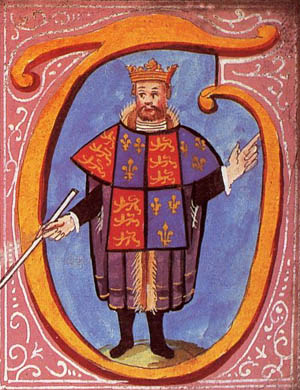
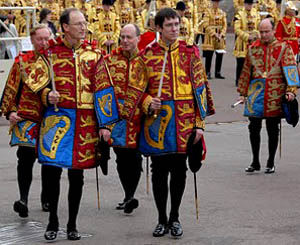
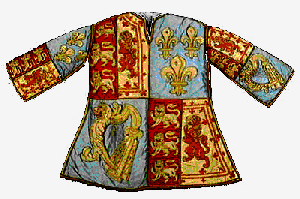
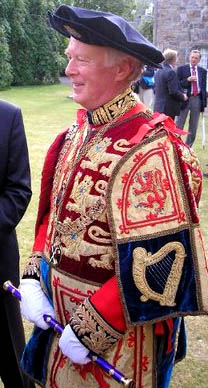
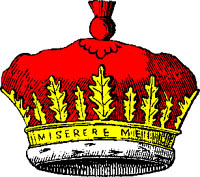
.gif)

